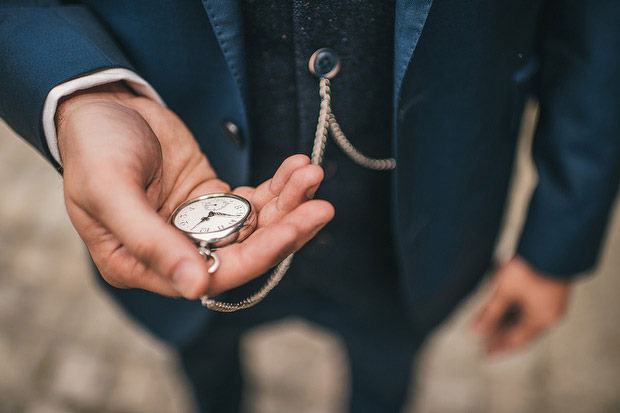The groom’s suit collections offer more and more options for the engaged couple to find their perfect outfit. Likewise, they have a vast repertoire of accessories to choose from to ensure that their look is consistent with their wedding style and, of course, the watch can’t go amiss. The good news is that this can be a great opportunity to give yourself a gift that is compatible with your personality because, just like the suit and its accessories, the watch can be worn after the big day! If you’re wondering how to choose the perfect watch, you’ve come to the right place. In today’s article, we discuss some of the different types of watches that are ideal for weddings.
Pocket Watches
The origin of portable clocks goes back to the century of innovations: the XV. In addition to pockets and pouches, they were used as necklaces and, although the fob attached to the wrist is not very practical, this use was improved with a leather strap that had a hole to place the watches.
In finery, it was considered inappropriate to measure time; therefore, women did not complement long party dresses with watches. Men wore these pieces in the pocket of the vest so that they were not visible and the fob crossed to the buttoning was the jewel that brought sophistication to the suits. In this way, a pocket watch can add distinction to your boyfriend look and you would have an accessory for very special occasions or to collect.
Classic Designs
In the more classic collections, white dials with indexes and Roman numerals predominate. The designs are inspired by the first mechanisms that did not go beyond the second. Since they don’t have many functions, the cases are discreet and these watches usually have natural or synthetic leather straps.
When it comes to suits and elegant evening dresses, less is more, but classic watches are also considered the most appropriate for these occasions, because the thickness of the strap and case allows the wrist of the shirt to move without it getting stuck or the cuff links getting stuck. The darker the strap, the more formal it is, and those with stitching that contrasts with the color of the strap are more casual.
Chronographs and Chronometers

Among the classic mechanisms that can be found in sophisticated collections are chronographs, which usually have two or three counters and one or two start, stop and reset buttons. Although they are often used synonymously, in order for them to be called chronometers, their accuracy must undergo a series of tests established by the Official Swiss Chronometer Testing Institute.
Armis or Metal Bracelets
In the late 19th century, wristwatches were officially manufactured as jewelry for women, and in the 20th century, the first pieces for men were designed for aviators so that they no longer had to attach their pocket watches to their legs or arms. Because of their strength, these watches were made with metal bracelets and, to differentiate them, they were called armis.
At that time, airplanes did not have the necessary instruments to calculate, for example, fuel consumption, hours and directions of flight. So altimeters, compasses, tachometers and chronographs were added to watches so that pilots could make more accurate calculations.
Unless you want to calculate the speed of your bride-to-be walking down the aisle or getting married underwater, even though aviator and dive watches have metal straps, they don’t belong at your wedding and formal events. However, a classic design or a discreet chronograph with a Milanese style strap are viable options to wear with a wedding suit.
Original Skeletons
If you love the mechanics of time, you can give your boyfriend look an original touch with a dial that leaves the clockwork bare, and these designs can be identified as skeleton. If the pieces without markers are not practical for you, you can find models with indexes or numbers and there are chronographs in which only the mechanics of the counters are visible.
Additional Tips to Matching the Watch with Your Outfit
Leather strap watches are usually coordinated with the color of the shoes and, if the suit requires it, also with the belt and metal finishes, such as cuff links. Gold accents go best with warm brown tones, and silver accents with cooler shades like blue or gray. Black is universally combinable.
In addition to your wedding outfit, consider how you will use the watch later. For example, if you want to reserve it for elegant events or if you want to wear it with more casual clothes you have in your wardrobe.
Just as metals, gemstones, design and brand influence the cost of engagement rings, watches should also be evaluated. While classic pieces are considered the most assertive for events like weddings, if you’re going to break the rules of formality, at least be reasonable, don’t you think?
If you’re going to start or expand your analog watch collection, what style of watch would you like to wear on your wedding day? Let us know in the comments below.





